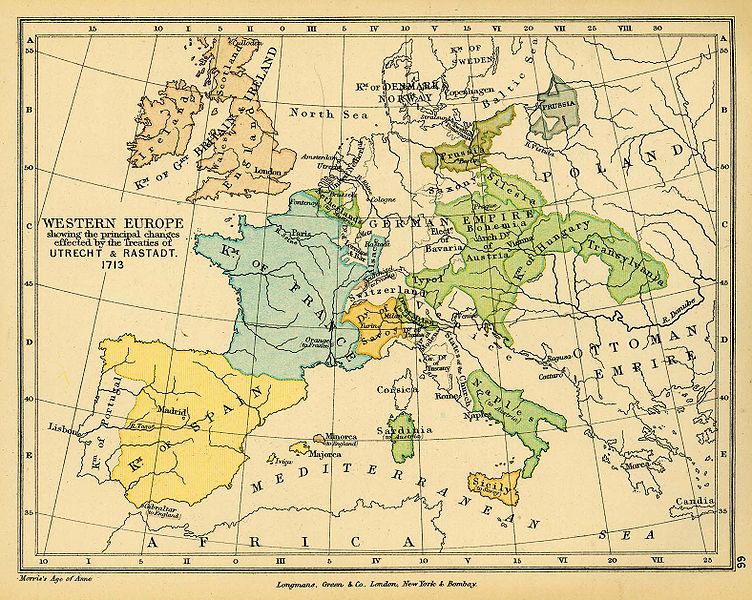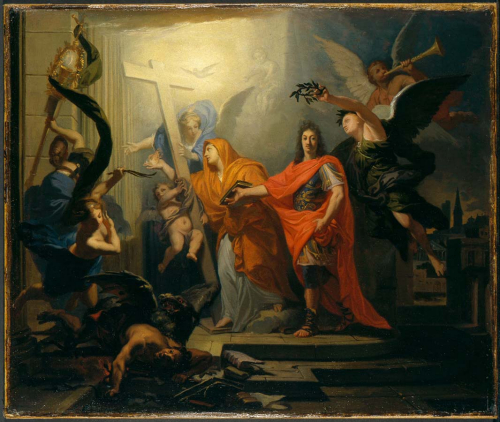Treaty of Utrecht - 300 years old
- Details
- Category: Utrecht - places to visit
The Treaty of Utrecht, which established the Peace of Utrecht, comprises a series of individual peace treaties, rather than a single document, signed by the belligerents in the War of the Spanish Succession, in the Dutch city of Utrecht in March and April 1713.
 The treaties between several European states, including Spain, Great Britain, France, Portugal, Savoy and the Dutch Republic, helped end the war. The treaties were concluded between the representatives of Louis XIV of France and Philip V of Spain on the one hand, and representatives of Anne, Queen of Great Britain, the Duke of Savoy, the King of Portugal and the United Provinces on the other.
The treaties between several European states, including Spain, Great Britain, France, Portugal, Savoy and the Dutch Republic, helped end the war. The treaties were concluded between the representatives of Louis XIV of France and Philip V of Spain on the one hand, and representatives of Anne, Queen of Great Britain, the Duke of Savoy, the King of Portugal and the United Provinces on the other.
The treaty registered the defeat of French ambitions expressed in the wars of Louis XIV and preserved the European system based on the balance of power.
Negotiations
France and Great Britain had come to terms in October 1711, when the preliminaries of peace had been signed in London. This initial agreement was based on a tacit acceptance of the partition of Spain's European possessions. Following this, a congress opened at Utrecht on 29 January 1712, with the British representatives being John Robinson, Bishop of Bristol, and Thomas Wentworth, Lord Strafford. Reluctantly the United Provinces accepted the preliminaries and sent representatives, but the Emperor refused to do so until he was assured that these preliminaries were not binding. This assurance was given, and so in February the Imperial representatives made their appearance. As Philip was not yet recognized as its king, Spain did not at first send plenipotentiaries, but the Duke of Savoy sent one, and Portugal was represented by D. Luís da Cunha.
One of the first questions discussed was the nature of the guarantees to be given by France and Spain that their crowns would be kept separate, and matters did not make much progress until after 10 July 1712, when Philip signed a renunciation. With Great Britain and France having agreed a truce, the pace of negotiation now quickened, and the main treaties were finally signed on 11 April 1713.
Principal provisions
 By the treaties' provisions, Louis XIV's grandson Philip, Duke of Anjou was recognized as King of Spain (as Philip V), thus confirming the succession as stipulated in the will of the late King Charles II. However, Philip was compelled to renounce for himself and his descendants any right to the French throne, despite some doubts as to the lawfulness of such an act. In similar fashion various French princelings, including most notably the Duke of Berry (Louis XIV's youngest grandson) and the Duke of Orléans (Louis's nephew), renounced for themselves and their descendants any claim to the Spanish throne.
By the treaties' provisions, Louis XIV's grandson Philip, Duke of Anjou was recognized as King of Spain (as Philip V), thus confirming the succession as stipulated in the will of the late King Charles II. However, Philip was compelled to renounce for himself and his descendants any right to the French throne, despite some doubts as to the lawfulness of such an act. In similar fashion various French princelings, including most notably the Duke of Berry (Louis XIV's youngest grandson) and the Duke of Orléans (Louis's nephew), renounced for themselves and their descendants any claim to the Spanish throne.
Spain's European empire was also divided: Savoy received Sicily and parts of the Duchy of Milan, while Charles VI (the Holy Roman Emperor and Archduke of Austria), received the Spanish Netherlands, the Kingdom of Naples, Sardinia, and the bulk of the Duchy of Milan. Portugal had its sovereignty recognised over the lands between the Amazon and Oyapock rivers, in Brazil. In 1715, the Portuguese also recovered Colonia del Sacramento, taken by Spain in Uruguay.
In addition, Spain ceded Gibraltar and Minorca to Great Britain and agreed to give to the British the Asiento, a valuable monopoly slave-trading contract. In North America, France ceded to Great Britain its claims to Newfoundland, Acadia and to the Hudson's Bay Company territories in Rupert's Land, . The formerly partitioned island of Saint Kitts was also ceded in its entirety to Britain. France was required to recognize British suzerainty over the Iroquois and commerce with the Far Indians was to be open to traders of all nations. France retained its other pre-war North American possessions, including Île-Saint-Jean (now Prince Edward Island) as well as Île Royale (now Cape Breton Island), on which it erected the Fortress of Louisbourg.
A series of commercial treaties were signed also.
After the signing of the Utrecht treaties, the French continued to be at war with Emperor Charles VI and with the Holy Roman Empire itself until 1714, when hostilities were ended with the Treaty of Rastatt and the Treaty of Baden. Spain and Portugal remained formally at war with each other until the Treaty of Madrid in 1750, while the British and the now-Bourbon Spain did not conclude peace until 1720.
Responses to the treaties
 The treaty's territorial provisions did not go as far as the Whigs in Britain would have liked, considering that the French had made overtures for peace in 1706 and again in 1709. The Whigs considered themselves the heirs of the staunch anti-French policies of William III and the Duke of Marlborough. Indeed, later in the century the Whig John Wilkes contemptuously described it as like "[the] Peace of God, for it passeth all understanding". However, in the Parliament of 1710 the Tories had gained control of the House of Commons, and they wished for an end to Great Britain's participation in a European war; Queen Anne and her advisors had also come to the same position.
The treaty's territorial provisions did not go as far as the Whigs in Britain would have liked, considering that the French had made overtures for peace in 1706 and again in 1709. The Whigs considered themselves the heirs of the staunch anti-French policies of William III and the Duke of Marlborough. Indeed, later in the century the Whig John Wilkes contemptuously described it as like "[the] Peace of God, for it passeth all understanding". However, in the Parliament of 1710 the Tories had gained control of the House of Commons, and they wished for an end to Great Britain's participation in a European war; Queen Anne and her advisors had also come to the same position.
The party in the administration of Robert Harley (created Earl of Oxford and Mortimer on 23 May 1711) and the Viscount Bolingbroke proved more flexible at the bargaining table and were characterised by the Whigs as "pro-French"; Oxford and Bolingbroke persuaded the Queen to create twelve new "Tory peers" to ensure ratification of the treaty in the House of Lords.
Although the fate of the Spanish Netherlands in particular was of interest to the United Provinces, Dutch influence on the outcome of the negotiations was fairly insignificant, even though the talks were held on their territory. The French negotiator Melchior de Polignac taunted the Dutch with the bon mot De vous, chez vous, sans vous, meaning that negotiations would be held "about you, in your country, without you." The fact that Bolingbroke had secretly ordered the British commander, the Duke of Ormonde, to withdraw from the Allied forces before the Battle of Denain (informing the French, but not the Allies), and the fact that they secretly arrived at separate peace with France was a fait accompli, made the objections of the Allies pointless.[5] In any case, the Dutch achieved their condominium in the Austrian Netherlands with the Austro-Dutch Barrier Treaty of 1715.
Balance of power
The European concept of the balance of power, first mentioned in 1701 by Charles Davenant in Essays on the Balance of Power, became a common topic of debate during the war and the conferences that led to signing of the treaties. Boosted by 19 April 1709 issue of Daniel Defoe's A Review of the Affairs of France, a periodical that supported the Harley ministry, the concept was a key factor in British negotiations, and was reflected in the final treaties. This theme would continue to be a significant factor in European politics until the time of the French Revolution (and was to resurface in the nineteenth century).
